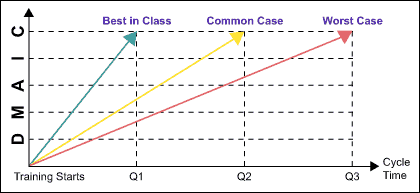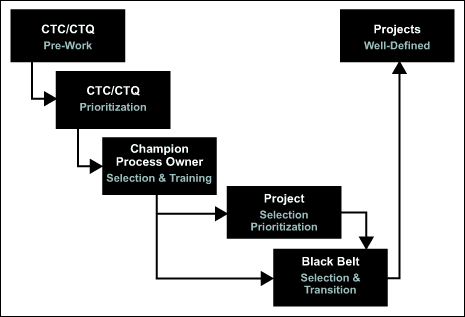
Anyone who has deployed Six Sigma, or has thought about deploying Six Sigma, is familiar with the main stumbling blocks to a successful deployment – lack of senior leader support, lack of data, longer-than-expected project cycle time, part-time Black Belt resources, and most important, poorly defined projects.
Since the first financial firm started deploying Six Sigma in 1996, quality professionals still face the same common deployment challenges. Why? The answer is found in the quality of the deployment planning process. To address these common issues in advance and mitigate the risk of failure, deployment leaders, Champions and Master Black Belts should consider using two key requirements of a good deployment planning process:
- Six Sigma success equation
- Readiness assessment for Six Sigma
Six Sigma Success Equation
What is the Six Sigma success equation? Simply put, a successful Six Sigma deployment requires the following components prior to the first wave of training – the right Belts, the right projects and the right support system. Or, a variation of the formula Y = f(x1, x2, x3):
Success = f (RBelts, RProjects, RSupport System)
1. The right Belts means all of them, from Yellow Belts up through Master Black Belts.
2. The right projects mean well-defined projects and should include a robust pipeline of projects at a ratio of two projects per active Belt at any given time.
3. The right support means a complement of passionate Champions, involved senior leaders, highly analytical and skilled data owners, excellent and available subject matter experts and process owners, the right financial representatives, a robust financial management and reporting system, an excellent human resources support system, good and available data, the right metrics and validated measurement systems, and a good Six Sigma training vendor and curriculum customized to the organization’s culture and needs.
These three critical x’s in the success equation drive the quality of a successful deployment. Having the top quality in these areas, or best-in-class level, requires several key specifics to be completed by the first day of training – Black Belts that are 100 percent dedicated, well-defined projects in which their initial “cost of poor quality” is signed off by the finance department, and a strong support infrastructure. Unfortunately, the common case deployment scenario is what many organizations experience: Not all Black Belts have well-defined projects or are 100 percent dedicated, the financial/customer benefits of projects are not easily identified, and the support system is too weak. Fortunately, fewer organizations experience the worst case scenario: Poorly selected Black Belts, poorly defined projects with little or no financial/customer benefits, almost no support system, and attrition of Belts and Champions.
What can assure the greatest chance for a company to have a best-in-class scenario? The answer is the quality of the deployment planning.
Selecting the Right Belts
Because Six Sigma is a project-based methodology, one deployment success factor is the cycle time of Black Belt training projects. Now, what would be the best-in-class scenario in terms of cycle time of Six Sigma projects? If a Black Belt starts a project the same day as starting DMAIC training, then would it be perfect if at the end of the Control phase of the training, the project also were at the Control phase? This represents a project completion time of four months.

While some firms achieve a best-in-class average of a four-month cycle time on training projects, as shown in Figure 1, others spend more than three quarters – nine months – completing the projects.
One of the most challenging and critical aspects of Six Sigma is selecting the best of the best within the organization to be full-time Black Belts or part-time Green Belts. Successful Black Belts are the kind of employees who overcome virtually all barriers to successful project completion – even such basic problems as poor project selection, lack of Six Sigma infrastructure, poor Champion support and lack of data. The process of selecting candidates for Black Belt training must be thorough. It is important to allow enough time and devote enough effort to the task. A company should start by looking for persons with a well-balanced set of leadership, analytical and project management skills.
The process should include the following considerations:
- Begin selecting the right Belts while building the pipeline of projects in order to match project complexity with the skill sets and experience of Black Belts.
- Transition the current responsibilities of Black Belt candidates to others in the company, so that each Black Belt candidate is 100 percent dedicated to Six Sigma on the first day of training. (See Figure 1.)
Selecting the Right Projects
The selection process starts by defining and implementing a project pipeline strategy, followed by several project selection workshops. A project pipeline strategy identifies items which are critical to customers (CTCs) or critical to quality (CTQs). Next, CTCs are prioritized and Champions are nominated and selected. Financial representatives, data owners and process owners are key players in this process and should be nominated and trained at this point as well, since the prioritization process often requires some data mining or process mapping. The end result is worthwhile as the cycle time of the projects will be shortened. (See Figure 2.)
Project selection is a never-ending process in Six Sigma. It starts two or three months prior to the first day of training, but has no end. Everyone in the company should be encouraged to suggest project ideas.
The success of the project selection process and project pipeline is measured by two factors – the cycle time of projects and the number of projects per active Belt that are in the pipeline.

Right Support System in Place
Even before building the project pipeline and simultaneously selecting the best of the best to be Black Belt candidates, an organization must begin to develop an infrastructure to support its Six Sigma deployment. This process can take anywhere from three to six months.
It begins with identifying a long- and short-term Six Sigma strategy for the organization. The strategy underlines not only the goal, mission and vision of Six Sigma for the organization, but also the required resources and the risks associated with a potential failure.
The support system must be comprised of the best Champions, subject matter experts, financial representatives, human resources representatives, data owners and process owners within the company. These key players must be trained prior to the Black Belts – usually a long process with results that may be hard to measure immediately. However, a strong infrastructure will pay off in supporting the project efforts. A well-understood financial system is needed to track, report, validate, and book Six Sigma financial benefits holistically throughout the organization. Finally, the organization’s human resources department needs policies and procedures to support the Six Sigma deployment.
Readiness Assessment for Six Sigma
When nominating Champions, conducting project selection workshops and selecting Black Belts, the organization must be aware of any cultural and operational barriers that would prevent it from reaching its goals. Thus, the need for a readiness assessment to understand the positives and negatives in deploying Six Sigma. Two aspects of readiness need examination – cultural and operational.
Cultural Assessment: This type of assessment varies from simple observation to a formal survey of all employees. The goal of the assessment is to identify whether change will be accepted across the organization. And if so, at what speed can the change be implemented? Although cultural assessment may be perceived as an easy process, it is more difficult than organizational assessment.
In a cultural assessment, one must answer the following questions:
- How do senior leaders cascade important information throughout the organization?
- How are important decisions made?
- Who makes the decisions?
- How fast are the decisions implemented?
- How does the organization recognize successes and failures?
- How does the organization handle failures?
- Does everyone in the firm understand the mission, vision and strategy of the firm as a whole?
- Is everyone in the firm aware of the critical customer, revenue and operating expense issues across the firm?
- How does the firm set up corporate goals?
- How clear are these corporate goals?
- Are the corporate goals measurable?
Operational Assessment: An operational assessment measures the maturity of the processes, measurement systems and data systems in an organization. The questions that must be answered are:
- How does the organization measure success?
- Does the organization measure the right things?
- How often does the organization measure these things?
- Does the organization have a few metrics that all employees understand and use?
- Are decisions based on data or assumptions?
- Who owns each critical process?
- Who owns the data?
- Where is the data?
- Is data stored on spreadsheets on employee laptops or in a data warehouse?
- Has the data been validated?
- Are the company’s reports written in simple, scientific or financial terms, or free form using fuzzy language?
- Are there updated process maps of the most critical processes?
- Do the executives know what a process map is?
The answers to these and other cultural and operational questions together with the success equation provide a good understanding of whether an organization is ready to launch Six Sigma. But even more importantly, the success equation and the readiness assessment will provide an organization with the knowledge needed to build a tailored deployment plan that includes the right elements and mitigates the risk of failure.
One More Element for Success
One other key element of deployment success which cannot be over-emphasized is time: Time to plan well. Time to sell the initiative. Time to select the right talent across the firm. Time to select good projects. Time to build a robust infrastructure. Time to ask questions. Time to analyze the answers.